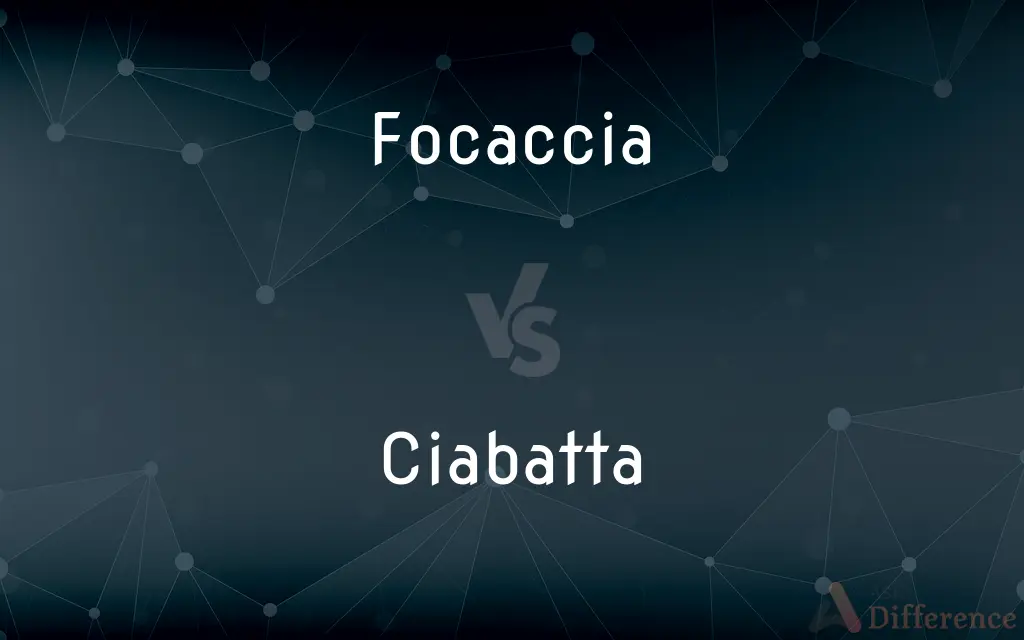Focaccia vs. Ciabatta — What's the Difference?
Edited by Tayyaba Rehman — By Urooj Arif — Updated on March 25, 2024
Focaccia is a flat, oven-baked Italian bread, typically seasoned with olive oil and herbs, while Ciabatta is known for its elongated shape and porous texture, ideal for sandwiches.

Difference Between Focaccia and Ciabatta
Table of Contents
ADVERTISEMENT
Key Differences
Focaccia is a traditional Italian bread that dates back to Ancient Rome, characterized by its flat, oven-baked nature and typically seasoned with olive oil, salt, and sometimes herbs. This bread is often dimpled to prevent it from rising too much and to hold onto the added flavors, making it a versatile choice for a variety of dishes. On the other hand, Ciabatta, which translates to "slipper" in Italian due to its shape, is a more recent invention from the 1980s, designed as Italy's answer to the baguette for sandwiches. Its most distinct feature is its airy, porous texture, achieved through high hydration in the dough, making it excellent for absorbing sauces and dressings without falling apart.
The texture of Focaccia is soft and chewy, with a rich flavor attributed to the olive oil and herbs baked into the crust and interior. It's often served as a side dish, used as a base for pizza, or simply enjoyed on its own. Whereas Ciabatta boasts a crusty exterior with a soft, light interior full of large holes. This structure makes Ciabatta bread ideal for hearty sandwiches, as it holds up well to being stuffed with various fillings and absorbing juicy ingredients without becoming soggy.
Focaccia's versatility extends to its variations; it can be topped with anything from rosemary and garlic to sun-dried tomatoes and olives, allowing for a wide range of flavor profiles. This flexibility makes it a popular choice for both savory and, occasionally, sweet applications. Ciabatta, in contrast, is typically left plain to highlight its unique texture and to serve as a neutral canvas for the flavors of sandwich fillings, although variations with olives or herbs can be found.
Regarding preparation, Focaccia dough is relatively easy to handle, with a consistency that allows for spreading and dimpling by hand. This accessibility makes it a favorite among home bakers. Ciabatta dough is much wetter and stickier, requiring a more experienced hand to manage its high hydration level, which is key to achieving its characteristic open crumb.
Focaccia and Ciabatta both play integral roles in Italian cuisine but serve different purposes. Focaccia is often used as an appetizer, snack, or side, perfect for dipping in olive oil or serving alongside meals. Ciabatta, with its robust structure, is preferred for making paninis and other sandwiches, proving that despite their shared origins, they cater to different culinary needs.
ADVERTISEMENT
Comparison Chart
Origin
Ancient Rome
Italy, 1980s
Texture
Soft and chewy, with a moist interior
Crusty exterior with a light, airy interior
Typical Uses
Side dish, pizza base, appetizer
Sandwich bread
Seasonings
Olive oil, herbs, sometimes toppings like tomatoes or olives
Generally plain to complement sandwich fillings
Dough Hydration
Lower than Ciabatta, easy to handle
Very high, sticky, and challenging to work with
Compare with Definitions
Focaccia
A flat, oven-baked Italian bread, often seasoned with olive oil and herbs.
For dinner, we had a rosemary focaccia, fresh from the oven.
Ciabatta
Features a crusty exterior with a soft, airy interior.
The ciabatta's crust was perfectly crunchy, contrasting with its airy inside.
Focaccia
Can be topped with various ingredients for different flavors.
I love focaccia topped with caramelized onions and olives.
Ciabatta
Primarily used for sandwiches due to its sturdy structure.
We packed our picnic basket with ciabatta sandwiches, filled with layers of Italian meats.
Focaccia
Relatively easy dough to manage, ideal for beginner bakers.
Making focaccia was my first baking success; the dough was forgiving and fun to dimple.
Ciabatta
An Italian white bread made from wheat flour and yeast, known for its elongated shape and porous texture.
For my sandwich, I chose a freshly baked ciabatta loaf.
Focaccia
Served as an appetizer, side, or base for other dishes.
We used slices of focaccia to create an impromptu pizza for lunch.
Ciabatta
Mostly plain, but sometimes found with olives or herbs.
I found a ciabatta with Kalamata olives baked into it, adding a nice salty bite.
Focaccia
Soft and chewy, typically dimpled to hold onto olive oil and seasonings.
The focaccia at the local bakery has the perfect chewy texture.
Ciabatta
High hydration dough requires skill to handle but results in a unique texture.
Working with ciabatta dough was challenging, but the open crumb texture it created was worth it.
Focaccia
Focaccia (Italian pronunciation: [foˈkattʃa]; Ligurian: fugassa [fyˈɡasa]) is a flat oven-baked Italian bread similar in style and texture to pizza; in some places, it is called "pizza bianca". Focaccia can be served as a side dish or as sandwich bread.
Ciabatta
Ciabatta (, Italian: [tʃaˈbatta]; literally "slipper") is an Italian white bread made from wheat flour, water, salt, yeast and olive oil, created in 1982 by a baker in Adria, province of Rovigo, Veneto, Italy, in response to the popularity of French baguettes. Ciabatta is somewhat elongated, broad, and flat, and is baked in many variations, although unique for its alveolar holes.
Focaccia
A flat Italian bread traditionally flavored with olive oil and salt and often topped with herbs, onions, or other items.
Ciabatta
A porous bread with a crispy crust, baked in a flattish, usually oblong loaf.
Focaccia
(uncountable) A flatbread similar in style, composition, and texture to modern pizza doughs and topped with herbs, cheese and other products. Focaccia typically consists of high-gluten flour, oil, water, sugar, salt and yeast.
Ciabatta
A broad, flat, white Italian bread.
Focaccia
(countable) A sandwich made with this type of bread.
Common Curiosities
How long do focaccia and ciabatta last?
Both breads are best enjoyed fresh, but can last up to 2-3 days when stored properly in airtight containers.
Can you freeze focaccia and ciabatta?
Yes, both focaccia and ciabatta can be frozen for up to a month, though their textures may slightly change upon thawing.
What makes ciabatta ideal for sandwiches?
Its sturdy structure and porous interior make it perfect for absorbing flavors without becoming soggy.
Can focaccia dough be used for ciabatta, and vice versa?
Due to differences in hydration and preparation, focaccia and ciabatta doughs are not typically interchangeable.
What is the main difference between focaccia and ciabatta?
Focaccia is a flat, seasoned bread, ideal for sides or snacks, while ciabatta is elongated and porous, perfect for sandwiches.
What are common toppings for focaccia?
Focaccia is commonly topped with rosemary, sea salt, olives, sun-dried tomatoes, and sometimes cheese, enhancing its flavor profile.
Are focaccia and ciabatta vegan?
Both breads can be vegan, but it depends on the specific ingredients used, such as whether the dough contains animal products like dairy.
Why does focaccia have dimples?
Dimples are made to prevent the bread from rising too much and to help retain the olive oil.
What are the best ways to enjoy focaccia?
Focaccia is versatile; enjoy it dipped in olive oil, as a side to meals, or topped with various ingredients as a snack.
Is ciabatta bread healthier than focaccia?
Healthiness depends on the specific recipes and personal dietary needs; ciabatta might have fewer calories if focaccia is heavily topped with oil and other ingredients.
Why is ciabatta sometimes considered difficult to bake?
The high hydration level of ciabatta dough makes it sticky and challenging to handle, requiring more advanced baking techniques to achieve the right texture.
How should ciabatta be sliced for sandwiches?
Ciabatta should be sliced horizontally, taking care not to compress its airy interior, to create an optimal base for sandwich fillings.
How does the hydration level of the dough affect the texture of focaccia and ciabatta?
Higher hydration in ciabatta dough contributes to its airy, porous texture, while focaccia's slightly lower hydration results in a softer, chewier bread.
Can focaccia or ciabatta dough be made ahead of time?
Yes, both doughs can be prepared in advance and refrigerated, with focaccia benefiting from a slow rise for deeper flavor, and ciabatta requiring careful timing due to its high hydration.
Can focaccia and ciabatta be made with whole wheat or gluten-free flour?
Yes, both breads can be made with alternative flours, like whole wheat for a nuttier taste or gluten-free blends, though texture and flavor may vary from traditional recipes.
Share Your Discovery

Previous Comparison
Objectivism vs. Subjectivism
Next Comparison
Dupatta vs. HijabAuthor Spotlight
Written by
Urooj ArifUrooj is a skilled content writer at Ask Difference, known for her exceptional ability to simplify complex topics into engaging and informative content. With a passion for research and a flair for clear, concise writing, she consistently delivers articles that resonate with our diverse audience.
Edited by
Tayyaba RehmanTayyaba Rehman is a distinguished writer, currently serving as a primary contributor to askdifference.com. As a researcher in semantics and etymology, Tayyaba's passion for the complexity of languages and their distinctions has found a perfect home on the platform. Tayyaba delves into the intricacies of language, distinguishing between commonly confused words and phrases, thereby providing clarity for readers worldwide.
















































